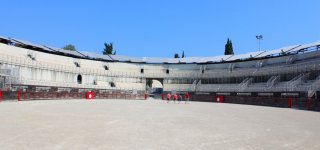The arenas of Frejus
First naval base in the Roman Mediterranean city labeled "City and Country of Art and History, Fréjus is also called the" Pompeii "Provencal for wealth and the preservation of its ancient remains. Founded by Caesar to supplant Marseille, Fréjus possessed in the first century BC, the only naval base in Roman Gaul. The port of Fréjus was then the second after the one of Ostia, the port of Rome.
The Frejus territory retains its ancient prosperity rich architectural heritage to the forefront which included the aqueduct of Mons, the amphitheater, the baths, a paved portion of the Via Aurelia, which linked Rome to Narbonne, as well as the port remains and the ancient walls. Particularly well preserved, the Fréjus arenas were the subject of a major restoration and rehabilitation program. They are now at the heart of the cultural life of Frejus.
The amphitheater was built in the 1st century, when the city of Fréjus wore his Roman name of Forum Julii. With 113 meters on 85, the building could accommodate up to 12,000 spectators. It was then located outside the city walls, leaning against a sandstone hill. The building itself is built in green sandstone and brownstone from local quarries.
In the first centuries AD, the Fréjus arenas have hosted the games traditional circus, that is to say, gladiator fights and wild, but perhaps representations of naval battles. Neglected from the 9th century, they were then used as a stone quarry during the Middle Ages and the first centuries of the modern era for the construction of individual houses and buildings Episcopalians.
The first archaeological excavations were undertaken in the amphitheater during the 19th century. After some investigations in 1817, serious studies began in 1828 under the direction of archaeologist and architect Charles Texier. A century later, in 1932 and 1933, from Arles Jules Formigé, a specialist in ancient heritage of the south of France and architect of historical monuments, also work on the site.
extremely deadly disaster, breaking the Malpasset dam in 1959 helped lift the dirt amphitheater until half-buried, the building was largely generated by the powerful surge of water.
Since 2007, Frejus arenas are subject to a comprehensive program of restoration and rehabilitation to allow the site to host major events safely for spectators and in accordance with the rules in force in the institutions designated receiving the public. The idea is not to recreate the ancient structure stands as part of a traditional restaurant, but building with modern materials in continuation of the ruins. The proportions and the original geometry of the building will be reproduced, and the existing remains sheltered degradations.
It is through this work, to give back to their arenas based on place of entertainment and performances: a vocation that they have already collected several times, especially with the organization at the site of a quarter-final Davis Cup in 1993.
The arenas of Fréjus be visited from Tuesday to Saturday in low season and from Tuesday to Sunday in high season. They host art events, concerts, festivals and bullfights. Among the varied programming venues include the electro Colo Summer festival, bullfights and bull pool, international meetings of petanque, the rural sports tournaments, freeride demos or trial, classical music concerts, or parties flamenco.
